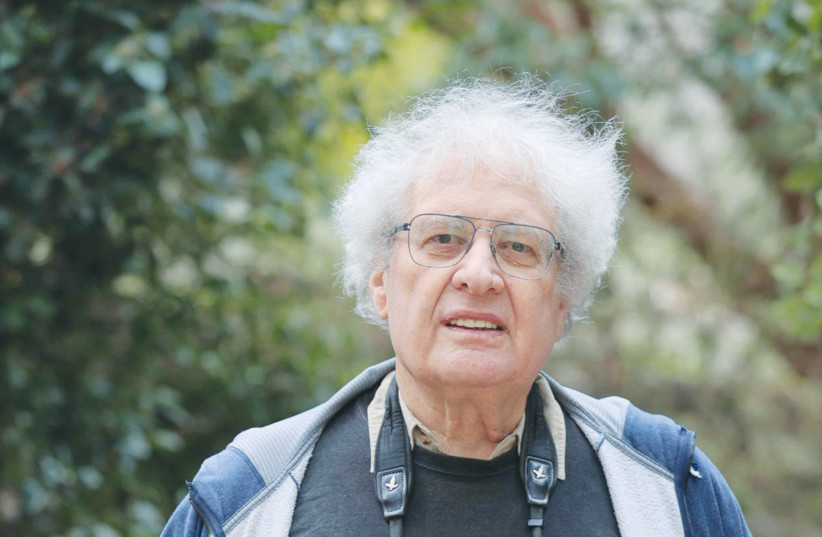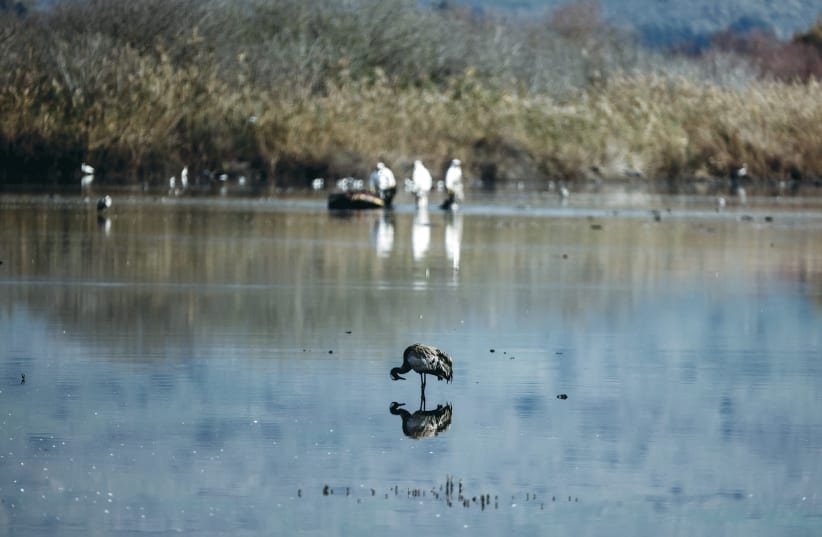We all need a happy place we can retreat to in our minds when we want to take a break from something stressful. Mine is the Hula Valley in northern Israel. I take deep breaths and relax by mentally traveling to the paradise for birds and human visitors. I recall past trips, watching cranes and other birds gracefully landing in the lake or noisily flocking to the fields at dusk, with Mount Hermon as a backdrop.
Sitting in a camouflaged safari truck in a field in the Hula Valley surrounded by thousands of pairs of courting cranes is a thrill you cannot get anywhere else in the world. It feels like being in a David Attenborough movie.
In an early COVID lockdown, I eagerly participated in a virtual tour of the Hula site with a guide pointing out the birdlife and other wildlife, which includes water buffaloes and swamp cats. I promised myself that someday soon I would go back in person for another dose of animal magic.
Now, I’m almost scared of what I’ll see. The Agamon Hahula lake area and KKL-JNF visitors’ center are currently closed because of the other devastating pandemic, the one that has been eclipsed by the ongoing corona crisis: Bird flu. Multiple strains of highly pathogenic avian influenza viruses have been detected worldwide in wild birds and poultry since July.
As Israel is located at a natural crossroads, some 500 million migratory birds of more than 500 species get a bird’s-eye view of the land twice a year. But the avian flu has taken its toll. So far, more than 5,280 cranes have died at Agamon Hahula and the final count is expected to be higher.


When I call world-renowned ornithologist Prof. Yossi Leshem to get his eagle-eye input on the situation, after initial reticence, he uses the words “tragedy” and “catastrophe.”
Leshem, a zoologist from Tel Aviv University and former head of the Society for the Protection of Nature in Israel, has many feathers in his cap, including a project to prevent airplanes being damaged or downed when birds get sucked into engines, and the use of barn owls as a biological pesticide – a project he works on in cooperation with the Palestinian Authority, Jordan, Morocco, Cyprus and Greece, among other places.
Leshem uses similar terminology to that used in the corona pandemic when describing the state of affairs. “The situation is complicated,” he says. “While at the moment, avian flu is affecting only the birds it could make the leap to affect other animals – including human beings.” There is always a fear of new, more virulent, variants.
The H5N1 bird flu has killed some 4,000 barnacle geese in England alone and has ripped through some 200 other spots in Europe, he notes. It is has been found in 40 countries in North America, Asia and Africa since July.
The main problem is population density. That’s why the flu is badly affecting battery hens and other factory farm birds. It’s also the problem with the cranes. As we know, birds of a feather flock together, but this means the disease is easily transmitted. This is particularly evident in the Hula which is an avian bottleneck in the migratory seasons.
Leshem returns to the disaster of the draining of the Hula swamps in the 1950s, a mammoth pioneering project aimed at preventing malaria. This ruined biodiversity in the area, affected the fertility of the farmland and also prevented the Hula acting as a filter stopping nitrates from reaching the Sea of Galilee (Lake Kinneret) which was the country’s main reservoir.
In the 1990s, the government and JNF-KKL decided to reflood part of the Hula. But the Agamon lake covered only a relatively small area of 1,000 dunams.
Before the reflooding, local agriculture was dominated by cotton fields that did not appeal to the cranes. Afterwards, there was a move to peanut farming – which made the area much more attractive for the birds. Cranes need two main conditions to thrive in winter, Leshem notes: Food and shallow water where they can stand and sleep at night.
To begin with some 1,000 cranes came but the numbers gradually rose. At the same time as the Hula was proving more attractive to the migratory birds, they were being forced out of other traditional sites like one in Ethiopia, where farmers began growing flowers for European markets.
The mass arrivals of birds in winter ruffled feathers of some of the local farmers who saw their crops being destroyed by the hungry winged visitors. Pelicans, storks, cormorants and a host of other birds fell prey to farmers who do not think of them as feathered friends. Hence, Israel implemented a project to deliberately feed the birds away from farmland. As the project took flight, it developed into the major tourism attraction that now exists – or did until the deadly combination of corona and bird flu.
Today, there are some 45,000 cranes at Agamon Hahula, Leshem notes. “Even those who don’t like birds can’t help but enjoy it. It’s a natural wonder.”
Part of the charm is watching the cranes’ courting dance and seeing the special relationship these birds have as families. Storks might have the image of delivering babies, but it is cranes that remain faithful to each other and share the parenting of their young. It is common to see two adult cranes with their young offspring – colts – standing between them.
But here lies another part of the tragedy: Without the adults, the young birds can’t survive even if they somehow escape infection. Workers at the site report seeing birds apparently mourning their dead.
The outbreak is also expected to cause great harm to many birds of prey and mammals that eat the carcasses.
SUFFERING FROM much worse PR, the mass deaths of poultry in poorer conditions are not grabbing as much attention as their more exotic cousins, but some 90,000 turkeys and more than half a million hens have also died from bird flu in Israel. Millions are being killed in a massive culling effort to stop the spread of the flu from factory farm to factory farm, hen coop to hen coop.
“This is an infection event of a magnitude we have not experienced here before,” said Agriculture Minister Oded Forer, who has taken matters under his wing, while Environmental Protection Minister Tamar Zandberg called the outbreak “the worst blow to wildlife in the country’s history.”
Here, too, reducing population density could help, Leshem notes. Indeed, Forer has been touting switching from factory farming in tiny cages to larger, open facilities both on humane grounds and as a means of preventing outbreaks of the disease which are spread via droppings. With rows of cages stacked on top of each other, it is a ready-made disaster.
Leshem paints a bleak picture of the current situation but also offers some suggested solutions. One is to combine the area of the Agmon Hahula tourism site and the nearby nature reserve when it comes to feeding the birds which would reduce the population density. Leshem’s motto is “Birds know no boundaries” so it is no surprise that he is also involved in international cooperation and treaties when it comes to preventing the spread of avian flu.
Although it is too late for this year, he says with advance warning, precautionary measures could be taken such as spraying the area against avian flu.
Pre-corona, some 400,000 to 500,000 visitors a year would go to the Hula on a very special form of pilgrimage – on a wing and a prayer. The income to the Upper Galilee region was estimated to be more than NIS 100m. per annum, proving that nature protection itself can be profitable.
The cranes will continue to come, Leshem says, as long as they are guaranteed food and a place to sleep. “Even if some 6,000 have died, they will continue to come to the Hula and remain here. That’s nature’s way. The numbers will rise again.”
This is a disaster but far from being a swan song for the birds.
I’m looking forward to traveling again in real life. The skies will open once more, and be safe for tourists and birds. The pandemics will pass and the Hula will be flying high.
liat@jpost.com
